Illinois Crop Update – May 17, 2024
Emily Hansen – Commercial Agriculture Educator
LaSalle County
Soil Conditions: Mildly Wet (soil is wetter than normal, local vegetation is healthy)
Some growers were able to take advantage of the nice weather over the weekend and get out in the field. Most corn that was planted earlier is at VE-V1, and soybeans are at VE-VC. There is minimal standing water, but fields remain fairly wet.
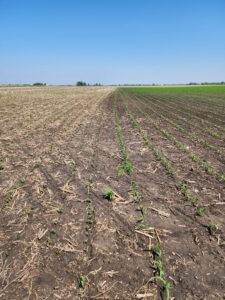
Figure 1: Left: soy; Right: corn
Russ Higgins – Commercial Agriculture Educator
Grundy County
Soil Conditions: Moderately Wet (soil is damp, standing water may be present in low areas, water bodies are full)
In Northeast Illinois some were fortunate to plant for several days while others have yet to attempt field work in the month of May. Crop scouting is critical to determine stand counts and the presence of drowned out areas. Waterhemp seedlings can easily be found in fields. For post herbicide applications be aware of weed height recommendations. A general rule is treating most weeds in the 3 to 4 inch stage.
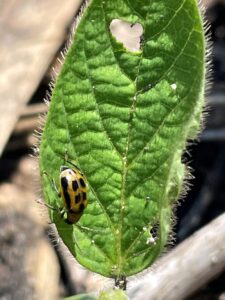
Figure 2: Leaf feeding – Bean leaf beetle
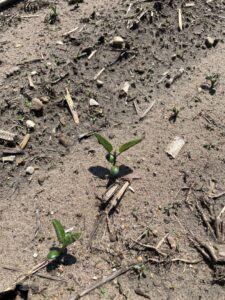
Figure 3: Waterhemp seedling
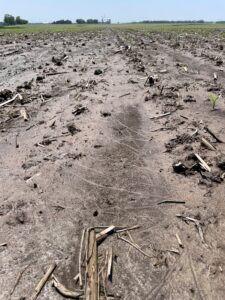
Figure 4: Waiting for replant opportunity
Meagan Diss – Commercial Agriculture Specialist
Knox County
Soil Conditions: Moderately Wet (soil is damp, standing water may be present in low areas, water bodies are full)
It’s been a wet spring thus far in West Central Illinois. Fields were starting to dry out over the weekend but scattered storms throughout the week have slowed progress once again. Earlier planted fields are looking better while some later plantings may show some emergence issues.
Reagan Tibbs – Commercial Agriculture Educator
Logan County
Soil Conditions: Mildly Wet (soil is wetter than normal, local vegetation is healthy)
The latter part of last week and weekend saw great conditions for fields to dry up and be suitable for fieldwork. Brief rain showers on Monday and Tuesday, combined with cooler temperatures, have stalled planting progress yet again for many local farmers. Many of the soybeans and corn that have emerged remain in the same growth stage as last week.
Talon Becker – Commercial Agriculture Specialist
Ford County
Soil Conditions: Moderately Wet (soil is damp, standing water may be present in low areas, water bodies are full)
Like much of the state, conditions in Ford County are fairly wet. Standing water in fields was minimal, for the most part, but most fields are at or near their holding capacity. During my transect of the southern half of the county, I saw very few emerged fields. The majority of fields are still yet to be planted, and many of those have not been sprayed or tilled yet this spring. I did see both corn and soybeans emerged in a couple fields, but still at VE/V1 and VC, respectively. There were several fields that had been recently planted prior to the last couple days of rain. Without too much more rain, those fields should come out of it okay.
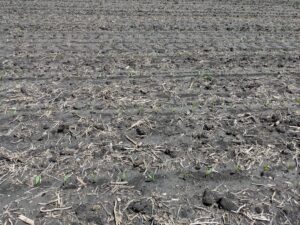
Figure 5: Corn field at VE/V1

Figure 6: Recently planted field with now saturated soil conditions
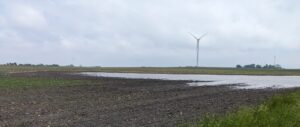
Figure 7: Standing water in emerged soybean field; indicative of the most extensive ponding witnessed during transect
Doug Gucker – Local Foods and Small Farms Educator
DeWitt, Macon, & Piatt Counties
Soil Conditions: Near Normal
Over the past week, rainfall in the three-county area of DeWitt, Macon, & Piatt has varied from about 0.25 to over 1.5 inches. Farmers were able to resume planting again this past weekend for a few days in some areas. Early planted corn and soybeans are in the V3 and V1 stages, respectively. Planting progress varies from nearly complete to 40% complete depending on how wet the soils have been.
Some fields are being planted without the emerged weeds being controlled by burndown herbicide applications or tillage.

Figure 8: Early planted corn and soybeans are in the V3 and V1 stages, respectively.
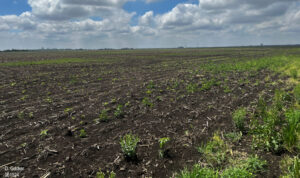
Figure 9: Soybean field planted this past weekend with no burndown.
Nick Seiter – Extension Field Crops Entomologist
Champaign County
Soil Conditions: Mildly Wet (soil is wetter than normal, local vegetation is healthy)
Alfalfa weevil reports have started to wind down a bit as the insects cycle out – they’re still out there in some areas, so stay vigilant. Black cutworm larvae will soon be large enough to cut plants and reduce stands; projected cutting dates based on moth trap densities and degree day accumulations are available here:
https://corn.ipmpipe.org/insects/black-cutworm/ (map at bottom of page).
Pay special attention to fields where winter annual weed control was delayed, and broadleaf weeds are present in the field and/or dying while the crop is emerging. A clean corn field is not a very attractive oviposition site for the moths and usually will not experience much cutting. Even in areas with high moth numbers, injury is sporadic, so don’t assume you’ll need to control just because you have some weeds.
Luke Merrit – Agriculture Research Specialist
Pike County
Soil Conditions: Moderately Wet (soil is damp, standing water may be present in low areas, water bodies are full)
It seems like this will be another wet week in Pike County. Over Mother’s Day weekend, there was a lot of planting and spraying being done. It seems like most farmers around here have very few acres left and some are even finished planting for the spring. With the exception of fields planted over last weekend, it appears that all other fields that are planted have emerged and appear to be doing well. This rainfall will provide adequate activation of residual herbicides to hopefully keep our fields free of weeds until post herbicide application timing.
Dane Hunter – Commercial Agriculture Specialist
St. Clair County
Soil Conditions: Moderately Wet (soil is damp, standing water may be present in low areas, water bodies are full)
It has been wet and very little if any planting has occurred in the last few weeks. Corn planted in April is up, although standing water has created dead areas that will require spot replants at very least. I’ve heard reports of 3″-7″ of rain throughout southern Illinois since May 1. Given the forecast, it may be a while before fieldwork can resume on non-tiled land.





